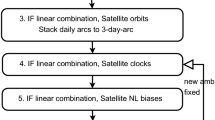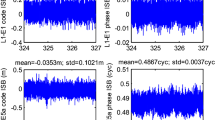Abstract
The current Galileo constellation in April 2017 comprises both in-orbit validation and full operational capability satellites transmitting signals on five frequencies, i.e., E1, E5a, E5b, E5, and E6. We analyze the power, multipath and noise of these signals using the data collected by four short baselines of various lengths and receiver/antenna types in Perth, Australia, as well as the Netherlands. In our analysis, the Galileo signals, except E5, show different relative noise and multipath performance for different receiver/antenna types. The E5 signal, with a weak dependency on the type of receiver/antenna, shows a significantly lower level of multipath and noise with respect to the other signals. Estimations of the E5 code standard deviation based on the data of each of the mentioned baselines gives a value of about 6 cm, which is further reduced to about 1 cm once the data are corrected for multipath. Due to the superior stochastic properties of E5 signal compared to the other Galileo signals, we further analyze the short-baseline real-time kinematic performance of the Galileo standalone E5 observations. Our findings confirm that the Galileo E5 data, if corrected for the multipath effect, can make (almost) instantaneous ambiguity resolution feasible already based on the current constellation.









Similar content being viewed by others
References
Afifi A, El-Rabbany A (2014) Single frequency GPS/Galileo precise point positioning using un-differenced and between-satellite single difference measurements. GEOMATICA 68:195–205
Amiri-Simkooei AR, Teunissen PJG, Tiberius CCJM (2009) Application of least-squares variance component estimation to GPS observables. J Surv Eng 135(4):149–160
Bock Y (1991) Continuous monitoring of crustal deformation. GPS World 2(6):40–47
Cai C, Luo X, Liu Z, Xiao Q (2014) Galileo signal and positioning performance analysis based on four IOV satellites. Navigation 67:810–824
Cai C, Gao Y, Pan L, Zhu J (2015) Precise point positioning with quad-constellations: GPS, BeiDou, GLONASS and Galileo. Adv Space Res 56:133–143
Cai C, He C, Santerre R, Pan L, Cui X, Zhu J (2016) A comparative analysis of measurement noise and multipath for four constellations: GPS, BeiDou, GLONASS and Galileo. Surv Rev 48:287–295
de Bakker PF, van der Marel H, Tiberius CC (2009) Geometry-free undifferenced, single and double differenced analysis of single frequency GPS, EGNOS and GIOVE-A/B measurements. GPS Solut 13(4):305–314
de Bakker PF, Tiberius CC, Van Der Marel H, van Bree RJ (2012) Short and zero baseline analysis of GPS L1 C/A, L5Q, GIOVE E1B, and E5aQ signals. GPS solut 16(1):53–64
Diessongo TH, Schüler T, Junker S (2014) Precise position determination using a Galileo E5 single-frequency receiver. GPS Solut 18(1):73–83
EL-Hattab AI (2013) Influence of GPS antenna phase center variation on precise positioning. NRIAG J Astron Geophys 2:272–277
ESA (2016) Galileo fact sheet. http://esamultimedia.esa.int/docs/galileo/Galileo-factsheet-2016.pdf
Estey LH, Meertens CM (1999) TEQC: the multi-purpose toolkit for GPS/GLONASS data. GPS Solut 3(1):42–49
Euler HJ, Goad CC (1991) On optimal filtering of GPS dual frequency observations without using orbit information. Bull Geodes 65(2):130–143
European Union (2015) European GNSS (Galileo) open service signal in space interface control document, OS SIS ICD, Issue 1.2, Nov 2015
Gaglione S, Angrisano A, Castaldo G, Freda P, Gioia C, Innac A, Troisi S, Del Core G (2015) The first Galileo FOC satellites: from useless to essential. In: 2015 IEEE international on geoscience and remote sensing symposium (IGARSS), IEEE, pp 3667–3670. doi:10.1109/IGARSS.2015.732661814
Genrich JF, Bock Y (1992) Rapid resolution of crustal motion at short ranges with the global positioning system. J Geophys Res 97:3261–3269
Gioia C, Borio D, Angrisano A, Gaglione S, Fortuny-Guasch J (2015) A Galileo IOV assessment: measurement and position domain. GPS Solut 19:187–199
GSA (2017) Galileo programme. https://www.gsc-europa.eu/galileo-gsc-overview/programme
Guo F, Li X, Zhang X, Wang J (2017) Assessment of precise orbit and clock products for Galileo, BeiDou, and QZSS from IGS multi-GNSS experiment (MGEX). Surv Rev 21:279–290
Hauschild A, Montenbruck O, Sleewaegen JM, Huisman L, Teunissen PJ (2012) Characterization of compass M-1 signals. GPS Solut 16(1):117–126
Hellemans A (2014) A simple plumbing problem sent Galileo satellites into wrong orbits. http://spectrum.ieee.org/tech-talk/aerospace/satellites/a-simple-plumbing-problem-sent-galileo-satellites-into-wrong-orbits
Hofmann-Wellenhof B, Lichtenegger H, Wasle E (2008) GNSS-global navigation satellite systems, GPS, GLONASS, Galileo and more. Springer, Berlin
Langley R (2014) ESA discusses Galileo satellite power loss, upcoming launch. http://gpsworld.com/esa-discusses-galileo-satellite-power-loss-upcoming-launch/. Published 20 Aug 2014
Langley RB, Banville S, Steigenberger P (2012) First results: precise positioning with Galileo prototype satellites. GPS World 23:45–49
Li X, Ge M, Dai X, Ren X, Fritsche M, Wickert J, Schuh H (2015) Accuracy and reliability of multi-GNSS real-time precise positioning: GPS, GLONASS, BeiDou, and Galileo. J Geod 89:607–635
Liu T, Yuan Y, Zhang B, Wang N, Tan B, Chen Y (2017) Multi-GNSS precise point positioning (MGPPP) using raw observations. J Geod 91(3):253–268
Lou Y, Zheng F, Gu S, Wang C, Guo H, Feng Y (2016) Multi-GNSS precise point positioning with raw single-frequency and dual-frequency measurement models. GPS Solut 20:849–862
Mader G (2002) GPS antenna calibration at the national geodetic survey. National Geodetic Survey, NOS, NOAA, Silver Spring, MD
Nadarajah N, Teunissen PJG (2014) Instantaneous GPS/Galileo/QZSS/SBAS attitude determination: a single-frequency (L1/E1) robustness analysis under constrained environments. Navigation 61(1):65–75
Nadarajah N, Teunissen PJG, Raziq N (2013) Instantaneous GPS–Galileo attitude determination: single-frequency performance in satellite-deprived environments. IEEE Trans Veh Technol 62(7):2963–2976
Nadarajah N, Khodabandeh A, Teunissen PJG (2015) Assessing the IRNSS L5-signal in combination with GPS, Galileo, and QZSS L5/E5a-signals for positioning and navigation. GPS Solut 20(2):289–297
Odijk D, Teunissen PJG, Huisman L (2012) First results of mixed GPS + GIOVE single-frequency RTK in Australia. J Spat Sci 57(1):3–18
Odijk D, Teunissen PJG, Khodabandeh A (2014) Galileo IOV RTK positioning: standalone and combined with GPS. Surv Rev 46:267–277
Odolinski R, Odijk D, Teunissen PJG (2015) Combined BDS, Galileo, QZSS and GPS single-frequency RTK. GPS Solut 19:151–163
Pan L, Cai C, Santerre R, Zhang X (2017) Performance evaluation of single-frequency point positioning with GPS, GLONASS, BeiDou and Galileo. Surv Rev. doi:10.1080/00396265.2016.1151628
Simsky A, Sleewaegen JM, Hollreiser M, Crisci M (2006) Performance assessment of galileo ranging signals transmitted by GSTB-V2 satellites. In: Proceedings of ION GNSS 2006, Institute of Navigation, Fort Worth, TX, USA, 26–29 Sept, pp 1547–1559
Simsky A, Mertens D, Sleewaegen JM, Hollreiser M, Crisci M (2008a) Experimental results for the multipath performance of galileo signals transmitted by GIOVE—a satellite. Int J Navig Observ. doi:10.1155/2008/416380
Simsky A, Sleewaegen JM, Wilde WD, Hollreiser M, Crisci M (2008b) Multipath and tracking performance of galileo ranging signals transmitted by GIOVE-B. In: Proceedings of ION GNSS 2008, Institute of Navigation, Savannah, Georgia, USA, 16–19 Sept, pp 1525–1536
Steigenberger P, Montenbruck O (2016) Galileo status: orbits, clocks, and positioning. GPS Solut 21(2):319–331
Steigenberger P, Hugentobler U, Montenbruck O (2013) First demonstration of Galileo-only positioning. GPS World 24:14–15
Tegedor J, Øvstedal O, Vigen E (2014) Precise orbit determination and point positioning using GPS, Glonass, Galileo and BeiDou. J Geod Sci 4:65–73
Tegedor J, Øvstedal O, Vigen E (2015) Estimation of Galileo uncalibrated hardware delays for ambiguity-fixed precise point positioning. Navigation 63:173–179
Teunissen PJG (1998) Success probability of integer GPS ambiguity rounding and bootstrapping. J Geod 72(10):606–612
Teunissen PJG (1999) An optimality property of the integer least-squares estimator. J Geod 73(11):587–593
Teunissen PJG, Amiri-Simkooei AR (2008) Least-squares variance component estimation. J Geod 82(2):65–82
Teunissen PJG, Montenbruck O (eds) (2017) Springer handbook of global navigation satellite systems. Springer, Berlin
Tranquilla JM, Cam JP, Al-Rizzo HM (1994) Analysis of a choke ring groundplane for multipath control in global positioning system (GPS) applications. IEEE Trans Antennas Propag 42(7):905–911
Verhagen S, Teunissen PJG (2014) Ambiguity resolution performance with GPS and BeiDou for LEO formation flying. Adv Space Res 54(5):830–839
Zaminpardaz S, Teunissen PJG, Nadarajah N (2016) GLONASS CDMA L3 ambiguity resolution and positioning. GPS Solut 21(2):535–549
Acknowledgements
The second author is the recipient of an Australian Research Council (ARC) Federation Fellowship (Project Number FF0883188). The Netherlands data were provided by Mr. Lennard Huisman from Kadaster, the Netherlands. This support is greatly acknowledged. We are also thankful to Dr. Nandakumaran Nadarajah and Dr. Mohammad Choudhury from Curtin University GNSS Research Center, Perth, Australia, for providing the data of UWA0 station.
Author information
Authors and Affiliations
Corresponding author
Rights and permissions
About this article
Cite this article
Zaminpardaz, S., Teunissen, P.J.G. Analysis of Galileo IOV + FOC signals and E5 RTK performance. GPS Solut 21, 1855–1870 (2017). https://doi.org/10.1007/s10291-017-0659-9
Received:
Accepted:
Published:
Issue Date:
DOI: https://doi.org/10.1007/s10291-017-0659-9




